SÃO TOMÉ
THE CHOCOLATE ISLAND WITH UNTAPPED POTENTIAL
THE CHOCOLATE ISLAND WITH UNTAPPED POTENTIAL
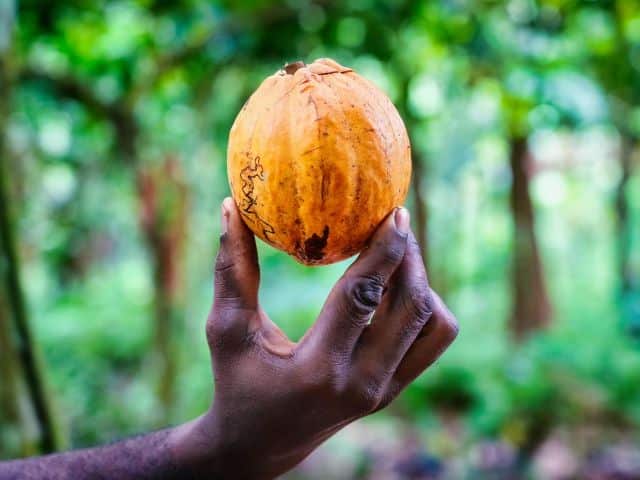
A HIDDEN GEM OF BIODIVERSITY
NATURE’S LITTLE TREASURE CHEST
Officially known as São Tomé and Príncipe, this two-island nation off the west coast of Africa remains largely unknown to the world. São Tomé is the larger and more populated of the two, while Príncipe is a pristine, forested jewel.
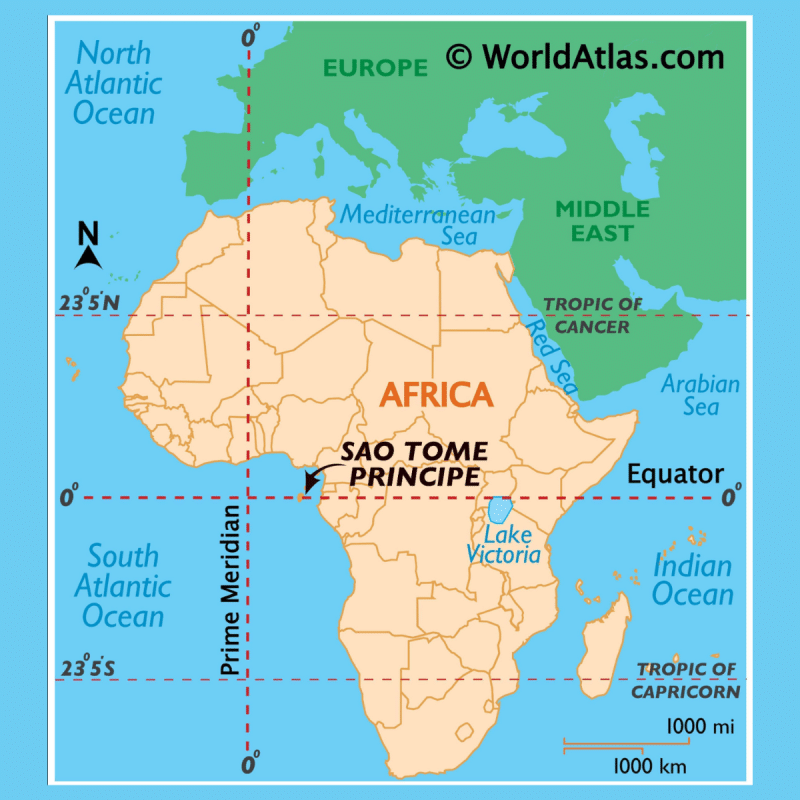
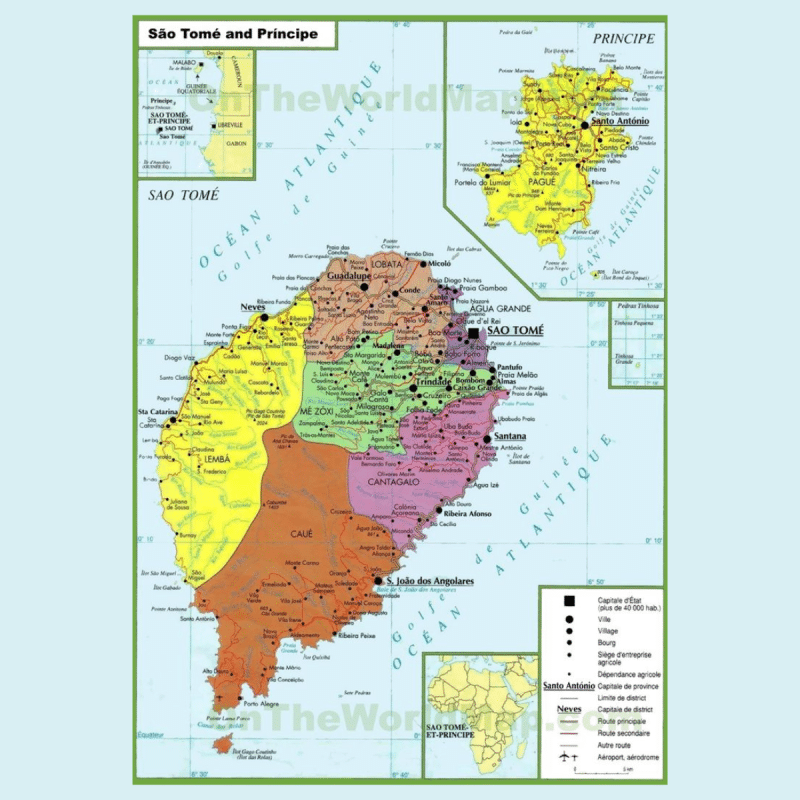
The islands themselves tell an ancient story: they were formed around 30 million years ago through volcanic activity deep beneath the Atlantic along the Cameroon Line. Over millennia, eruptions and interactions with seawater created a rich mosaic of igneous and volcanic rock, contributing to the complex soil composition and mineral diversity that now underpin the islands’ vibrant ecosystems.
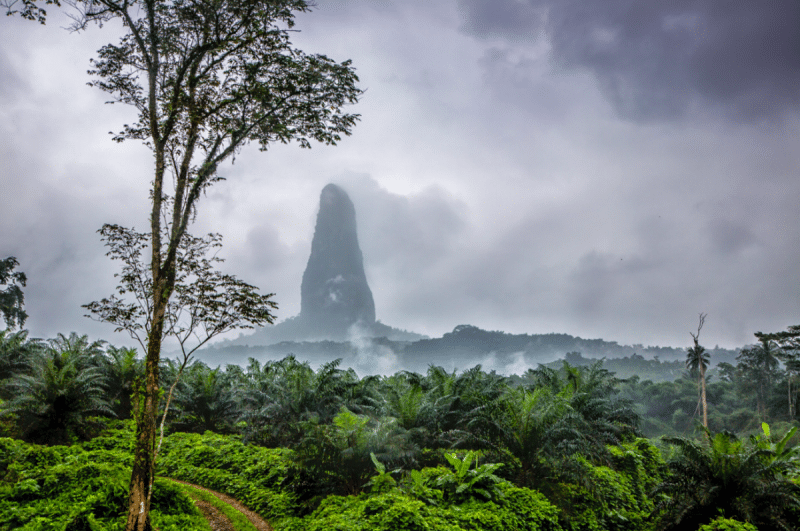
Until the 15th century, São Tomé was uninhabited -an isolation that helped preserve its extraordinary biodiversity. Though the island spans just 850 km², it is home to an astonishing array of wildlife: over 25 endemic bird species, approximately 69 endemic land vertebrates -including birds, reptiles, amphibians, and mammals -and more than 100 plant species found nowhere else on Earth. It’s no surprise that São Tomé has earned the nickname ‘the African Galápagos’.
The islands’ lush rainforests form the heart of their unique forestry ecosystem. These forests are vital habitats for endemic birds, primates, and rare plant species, while also playing a crucial role in regulating the local climate and conserving essential soil and water resources. They are fundamental to both the environment and the well-being of the people who depend on them. Two national parks, established in 2006, now protect nearly one-third of both islands, preserving landscapes that include dense cloud forests, mangroves, and volcanic highlands.
At Silva, we have a deep connection to this landscape. Cacao here thrives in rustic agroforestry systems that coexist harmoniously with the surrounding environment -it’s not just farming; it’s a walk through the forest.
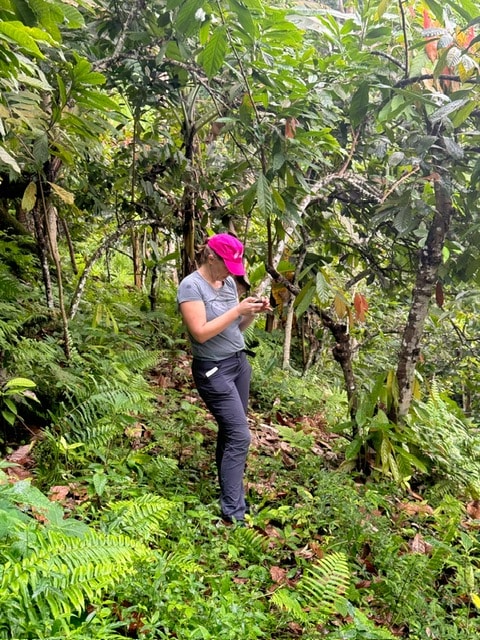
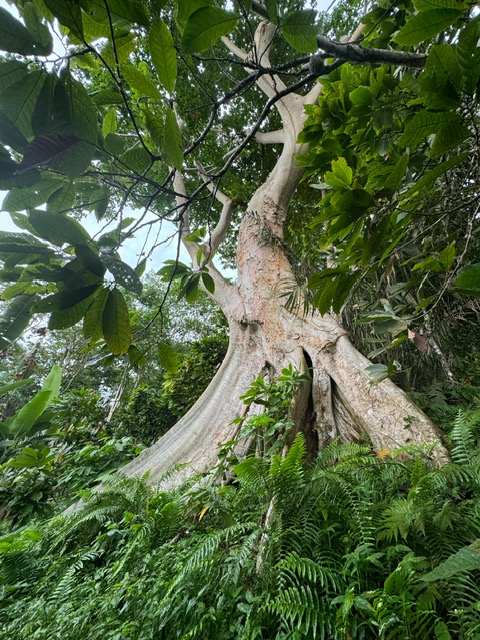
SAO TOME – ALMOST TAILOR-MADE FOR CACAO
NATURE’S LITTLE TREASURE CHEST
São Tomé offers ideal natural conditions for cultivating cacao. With warm tropical temperatures averaging 25°C, fertile volcanic soils, and consistent rainfall, the island provides a thriving environment for cacao trees. Farms here are often lush agroforestry systems, interwoven with crops like coffee, breadfruit, jackfruit, vanilla, papaya, coconut, and banana. Cacao is typically grown under shade in these biodiverse plots, where tradition and ecological stewardship go hand in hand. This biodiversity not only enhances the resilience of the ecosystem but also improves the quality of both cacao and its companion crops -making São Tomé’s cacao organic by nature -even in the absence of formal certification.
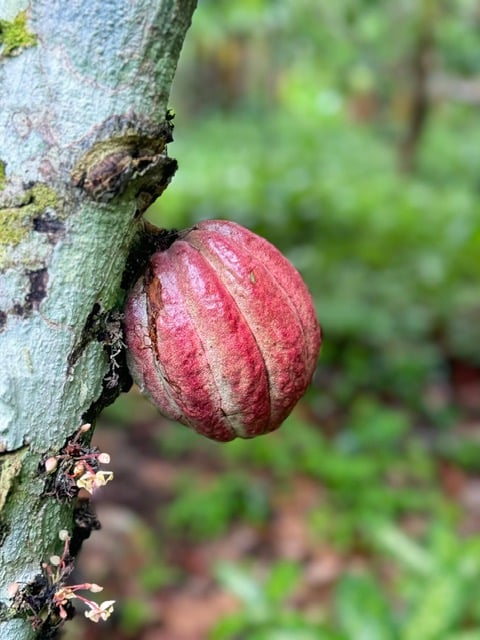

What makes São Tomé even more distinctive is the post-harvest system. Wet cacao mass is mostly collected and fermented centrally -a rare setup in Eastern & Western African cacao-producing countries. This structured process brings more control and consistency to post harvesting -helping to deliver a higher, more reliable quality.
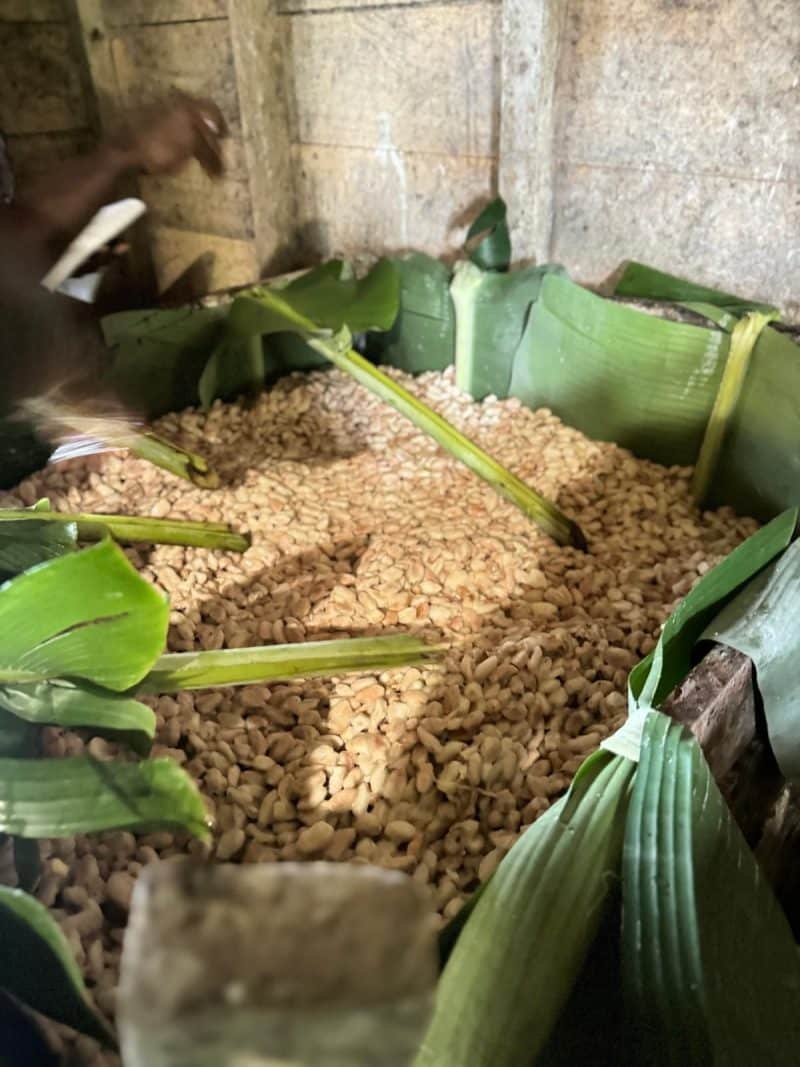
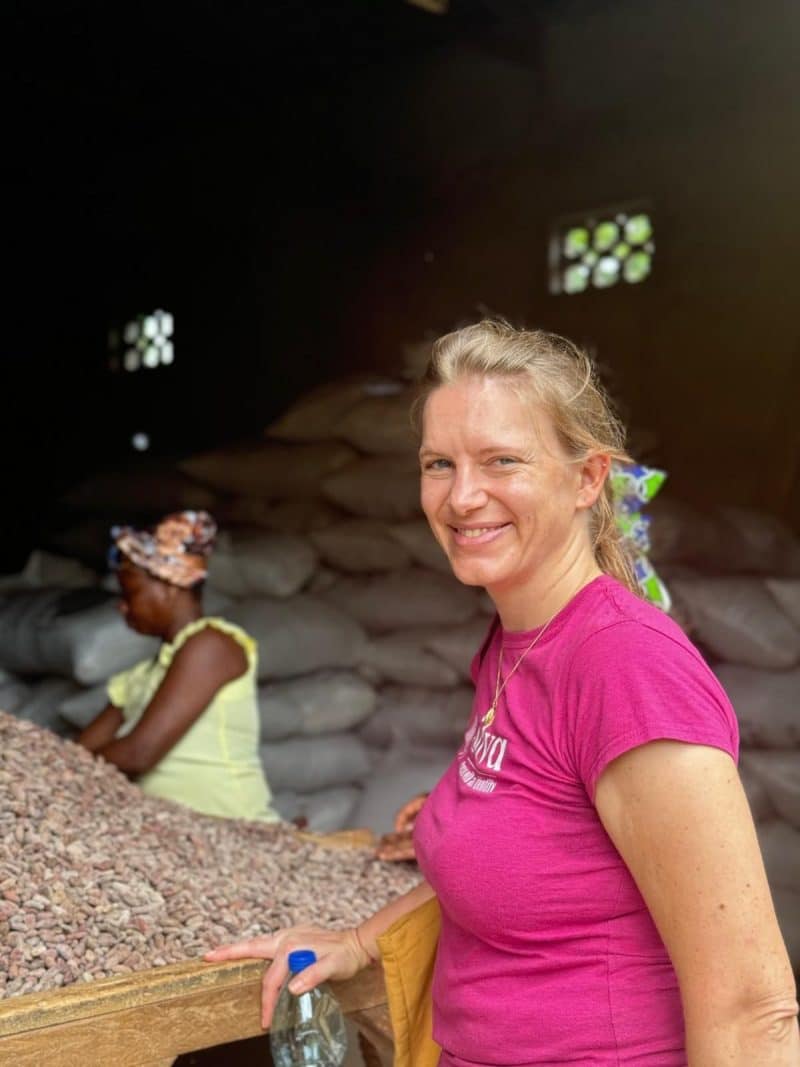
But despite the natural advantages, the island’s setting comes with serious challenges. With rain falling up to ten months a year, drying cacao becomes a delicate balancing act. High humidity makes it difficult to reduce moisture content, and even minor issues -like torn plastic covers or extended rain periods, can alter the final quality.
The difference can be seen in the colour of the beans, which may shift from the ideal reddish-brown to a less desirable grey tone. However, over the years we’ve learned that colour isn’t always the key indicator of quality -as shown in the picture below. It compares two batches processed with the same protocol, differing only by two days of fermentation. Despite the striking colour difference, the flavour remains consistent across both. This reinforces the need to look beyond physical appearance when assessing quality.
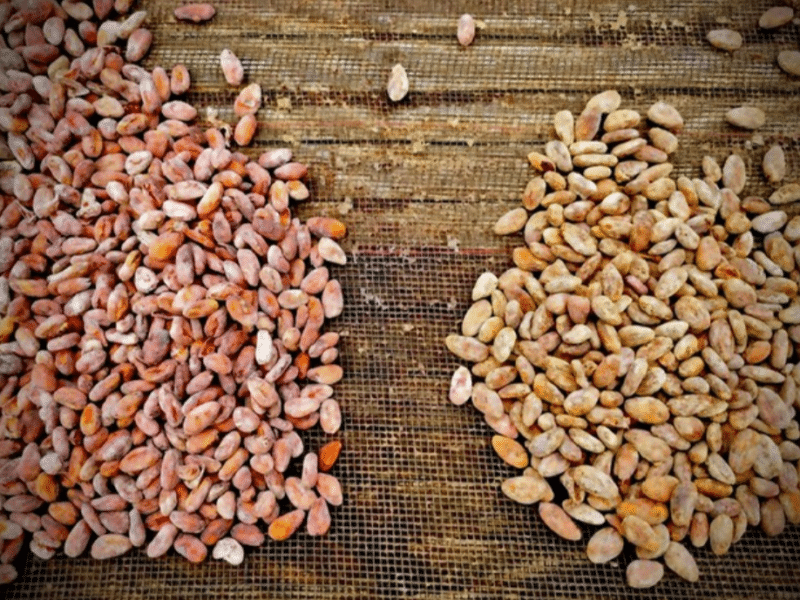
Still, where challenges exist, opportunity blooms. São Tomé’s unique combination of climate, biodiversity, and tradition offers enormous potential for producing exceptional cacao -if the right support, infrastructure, and attention are given. With continued care and innovation, this island may live up fully to its promise: a place almost tailor-made for cacao.
THE CHOCOLATE ISLANDS: A LEGACY ROOTED IN CACAO
The volcanic islands of São Tomé and Príncipe, nestled in the Gulf of Guinea along the Equator, are among the most unique cacao origins in the world. Their fertile, mineral-rich soils -born from volcanic activity, including dramatic peaks like Pico Cão Grande, create ideal conditions for high-quality cacao. It’s no coincidence that these islands earned the nickname ‘The Chocolate Islands‘.
In fact, São Tomé and Príncipe were the first place in Africa where cacao was cultivated at scale. When the Portuguese foresaw losing Brazil in the early 1800s due to witches’ broom disease, they brought cacao seedlings to the islands. The first trees arrived in 1819, and by the late 19th century, São Tomé had become the largest cacao producer in the world.
Uninhabited until the late 15th century, the islands were claimed by Portuguese explorers in 1486. Over the centuries, São Tomé became a key hub in the transatlantic slave trade and plantation agriculture. After early efforts with sugar, the Portuguese introduced coffee in 1780 and cacao in 1824, initially on Príncipe. São Tomé’s volcanic soils, warm temperatures, and high rainfall made it a perfect environment for cacao cultivation.
During colonial times, the islands were a popular escape for Portuguese elites. Grand cacao plantations, known as roças*, dotted the landscape. These estates were self-contained enclaves, complete with housing for enslaved workers and later contracted labourers, as well as schools, hospitals, and chapels.
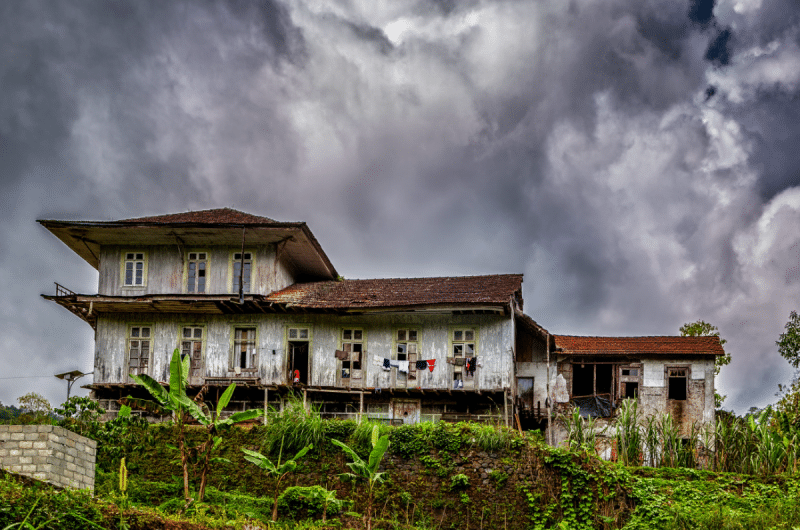
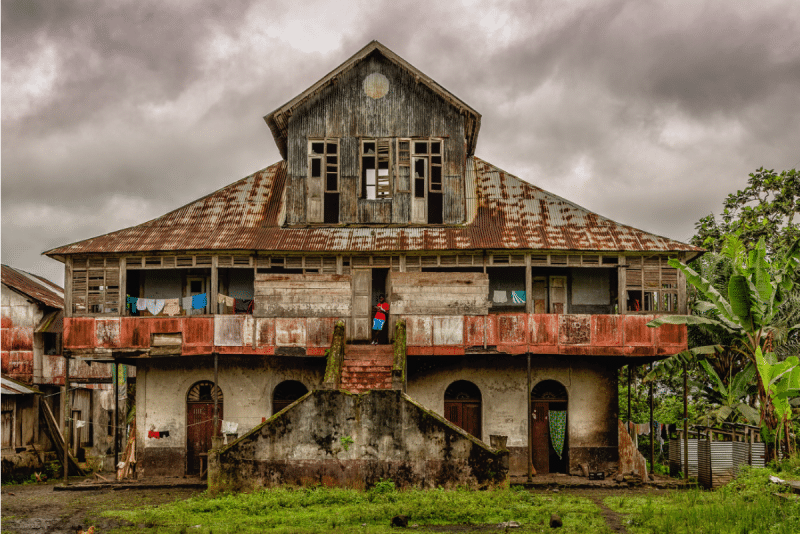
By the late 1800s, as global demand for cacao soared, Portuguese investors acquired large tracts of land from local crioulos**. By the early 1900s, São Tomé and Príncipe had become the world’s largest cacao exporter, earning the nickname ‘The Chocolate Islands’. By 1906, more than 70,000 hectares were dedicated to cacao cultivation. While impressive in scale and infrastructure, these plantations were built on systemic exploitation. Despite slavery’s formal abolition, forced labor practices continued well into the 20th century. Pressure from international critics -including British chocolate manufacturers, eventually brought attention to the abuses occurring on the plantations.
At the time of independence in 1975, cacao accounted for 54% of agricultural exports, and 90% of cultivated land was under plantation control, mostly by Portuguese estate owners.
Independence came on 12 July 1975, following the Carnation Revolution in Portugal. The Movement for the Liberation of São Tomé and Príncipe (MLSTP), founded in 1960, led the drive for sovereignty. Its leader, Manuel Pinto da Costa, became the first president and helped shape a new national identity, symbolised by the adoption of the flag, anthem, and coat of arms.
The flag is rich in meaning: green stands for the islands’ lush vegetation, yellow represents the tropical sun, red honours the struggle for independence, and two black stars symbolise the twin islands of São Tomé and Príncipe. The coat of arms, adopted at the same time, features a cacao pod–shaped shield with a central palm, held by a peregrine falcon and a grey parrot -icons of the islands’ biodiversity and their deep cultural and agricultural roots.
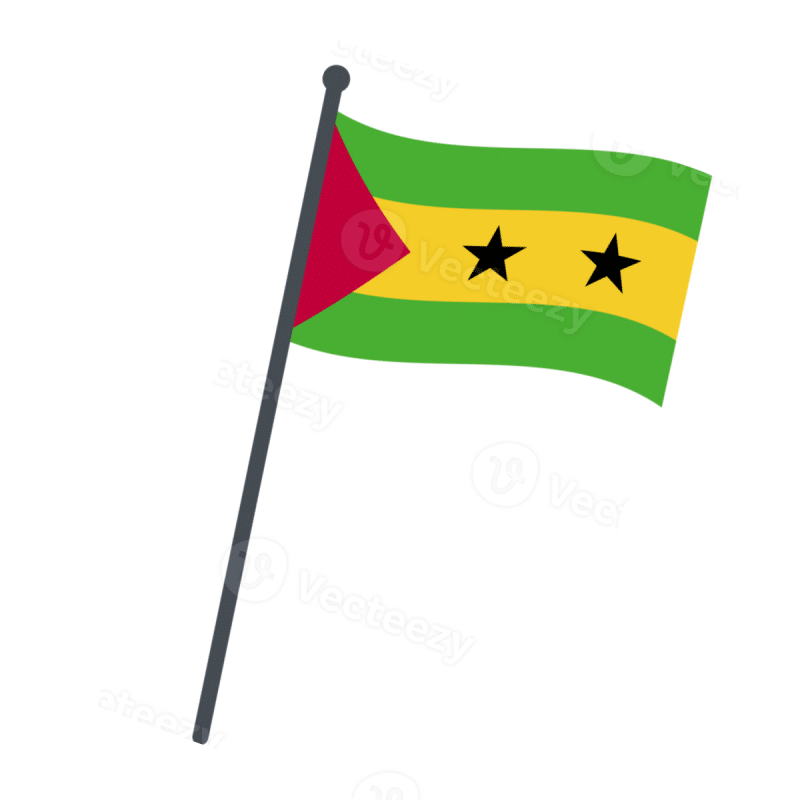
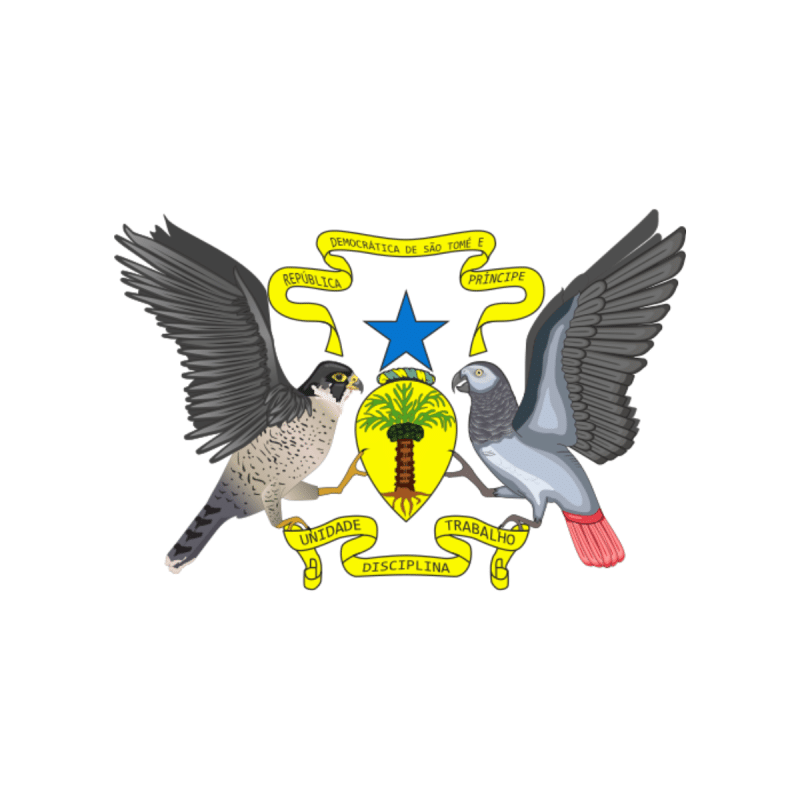
However, independence also brought significant disruption. With the departure of Portuguese settlers came a loss of technical and managerial expertise in cacao cultivation. The government nationalised the plantations, but production soon collapsed -from about 10,000 tons annually in 1975 to under 1,000 tons by the mid-1980s. The economy, long dependent on agriculture, faltered. Initially, land was organised into 15 state-run enterprises, most of which were eventually dissolved. In their place arose a patchwork of smallholder farms. Today, the landscape is a lush mosaic of backyard agroforests, where cacao grows alongside bananas, breadfruit, and native shade trees.
As global demand grows for fine cacao and ethically sourced products, São Tomé and Príncipe is slowly re-emerging on the chocolate map. Cacao, long intertwined with the islands’ history, remains their primary export -accounting for over half of agricultural exports. For many smallholder farmers, it is their main or only source of cash income.
Today, cacao remains the island’s primary export, accounting for over 50% of agricultural exports. For many farmers, cacao represents their sole source of cash income. With nearly two-thirds of the population living below the poverty line, we hope that the increase in global cacao prices over the last two years will begin to positively impact living conditions for local communities.
Visitors to São Tomé and Príncipe today encounter the remnants of its plantation past. Many roças (plantation estates) lie in ruins -abandoned, squatted by youth, or transformed into informal spaces. A few have been repurposed into boutique guesthouses or community hubs, offering a glimpse of their former grandeur. The islands hold enormous untapped potential, yet remain one of the least visited countries in the world, drawing only about 15,000 tourists annually.
The nation continues to face serious challenges. Despite decades of foreign aid and reforms supported by the IMF and World Bank, economic progress has been inconsistent. Structural weaknesses persist, and corruption and unemployment remain high. Brain drain is another concern, with many educated youth leaving to study abroad and not returning. Most investment still comes in the form of aid, while local industry -including small-scale chocolate production, is only beginning to take shape.
São Tomé and Príncipe’s cacao legacy is far from over. Once a central part of the islands’ history, cacao is now a symbol of resilience and renewal. As the world embraces the value of fine cacao and ethical sourcing, the islands have an opportunity to reclaim their place on the global chocolate map -this time on their own terms.
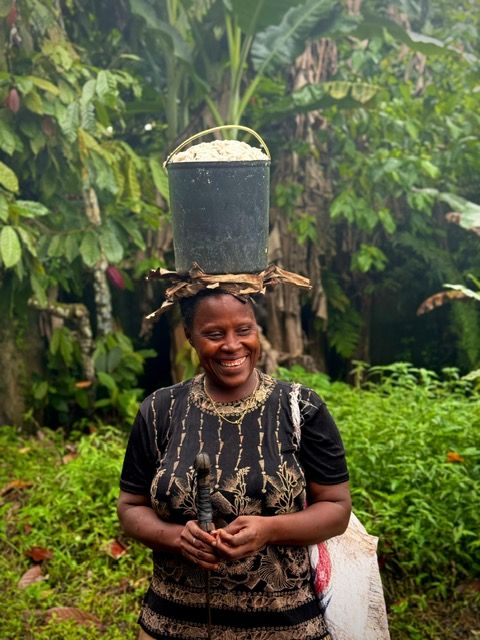
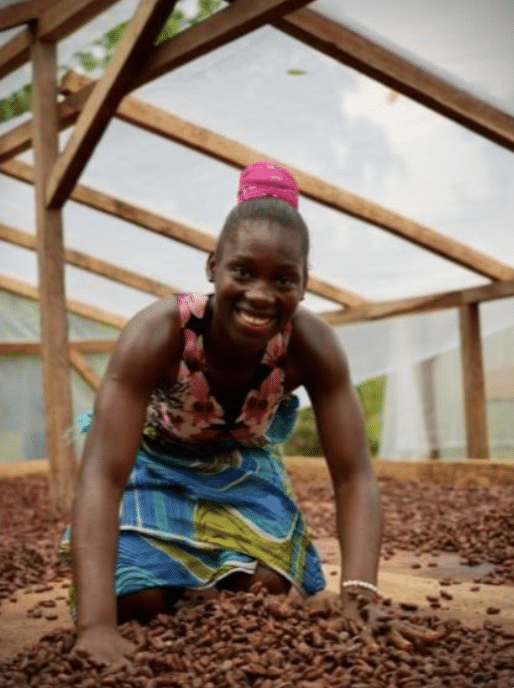
OUR LOCAL SÃO TOMÉ HEROES
In the small and vibrant archipelago of São Tomé and Príncipe, cacao networks are closely knit, and the impact of each grower is profound. At Silva Cacao, we’re proud to partner with two exceptional exporters -one cooperative and one private initiative -each doing important work to revive and uplift São Tomé’s rich cacao legacy.
CECAQ-11***
A COOPERATIVE FOR COMMUNITY, QUALITY & A SHARED FUTURE
Founded in 2008 by 221 cacao producers grouped into 11 associations from the historic roça Água Izé, CECAQ-11 emerged from a collective desire to unite forces for a stronger, fairer cacao value chain. Born out of a shared commitment to quality, fair pricing, and community empowerment, the cooperative was shaped by the vision of farmers such as Alberto do Sacramento Bidô, Deolinda de Mascarenhas Correia, Clementino Marques, Arlindo Nazaré dos Ramos da Cruz, Carlos da Vera Cruz Vaz Pereira, and Virieto Da Cruz, alongside rural development technicians Dionísio Amado, Cândido Rodrigues, João Tavares, Moisés Loureiro, Adalberto Luís, and Helder Pinto.
Officially established in the Cantagalo district of eastern São Tomé, CECAQ-11 has since expanded to include 21 primary cooperatives and 1,178 producers -over 40% of whom are women, collectively managing nearly 2,000 hectares of cacao. Several founding members, including Moisés Loureiro and Adalberto Luís, remain actively involved, with Luís now serving as Director. He emphasises that the cooperative’s strength lies in its diversity, even as variations in post-harvest infrastructure across the cooperatives present ongoing challenges.
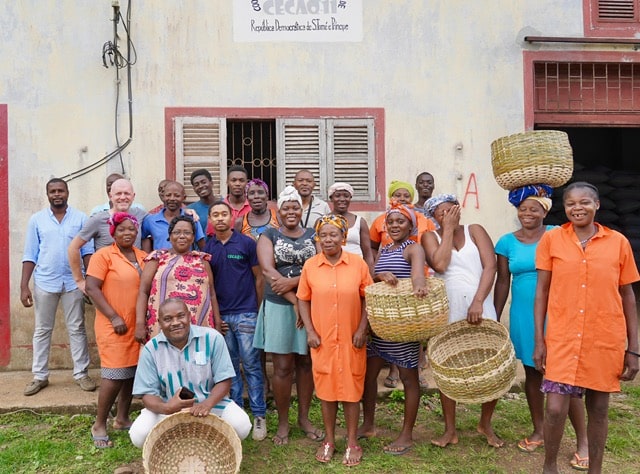
Since partnering with Silva in 2020, CECAQ-11 has further reinforced its mission, with centralized control over key stages such as drying, final bean selection, and export logistics helping ensure consistent quality across all lots.
Next up: In June 2025, CECAQ-11 is set to launch its very first small-scale experimental chocolate lab.
Director Adalberto Luís explains: ‘Together with our members, we decided to invest in a small-scale chocolate production line. This will not only help us deepen quality control at every stage of the supply chain -particularly important given varying post-harvest conditions, but also allow our members to finally taste chocolate made from their own beans. It’s a way of connecting more intimately with the fruits of our land.‘
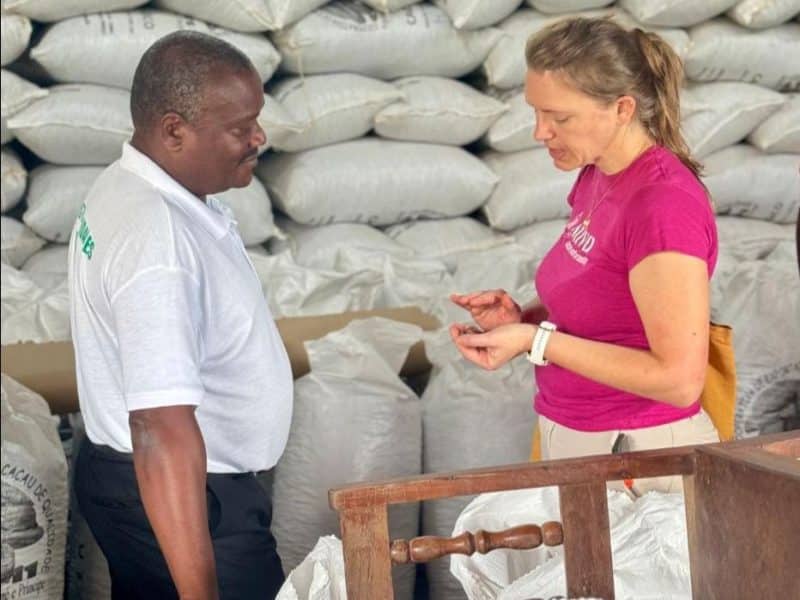
Every time the Silva Cacao team visits, our farmer-members light up with pride and curiosity as they taste chocolates made by our partner chocolate makers. These moments -full of recognition, discovery, and connection, are powerful. They spark not only joy, but also a deep and growing eagerness to learn more. Many farmers express a strong desire to understand the craft behind chocolate making and to take part in the next step: creating chocolate themselves. That’s why we’re launching a call.
CHOCOLATE MAKER WANTED
to Share Skills at CECAQ-11’s Micro Lab in São Tomé
CECAQ-11 -a cooperative deeply rooted in São Tomé’s cacao heritage, is launching its first micro chocolate lab, and we’re looking for an experienced chocolate maker to join us in this exciting venture.
We need someone who can share valuable hands-on knowledge in liquor and chocolate making, assist with the lab’s setup, and train CECAQ-11’s team in essential techniques, from fermentation to refining and tempering. Your expertise will directly benefit the cooperative members, local producers, and others involved in the lab, empowering them with the practical skills to take their cacao from farm to fine chocolate.
This is more than just a project; it’s an opportunity to create lasting change by building skills and capacity within the community, helping to establish a small-scale chocolate-making operation that adds value locally to São Tomé’s high-quality cacao.
If you’re passionate about sharing your craft, supporting a cooperative, and making a meaningful impact on a new initiative, we’d love to hear from you.
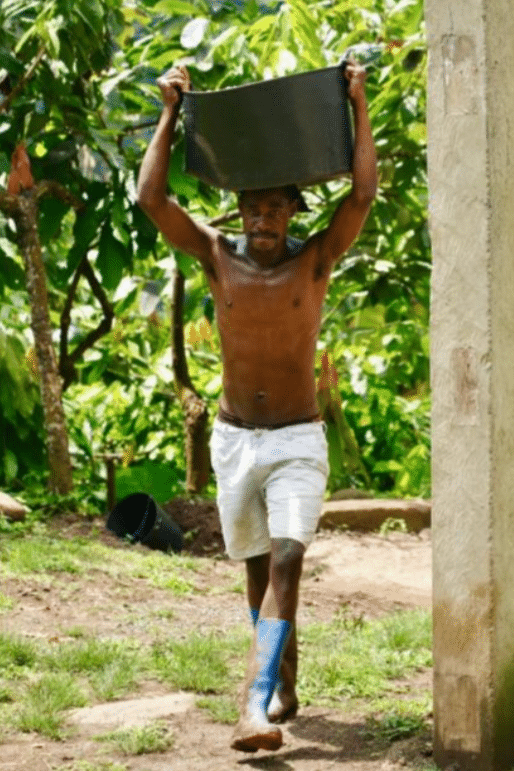
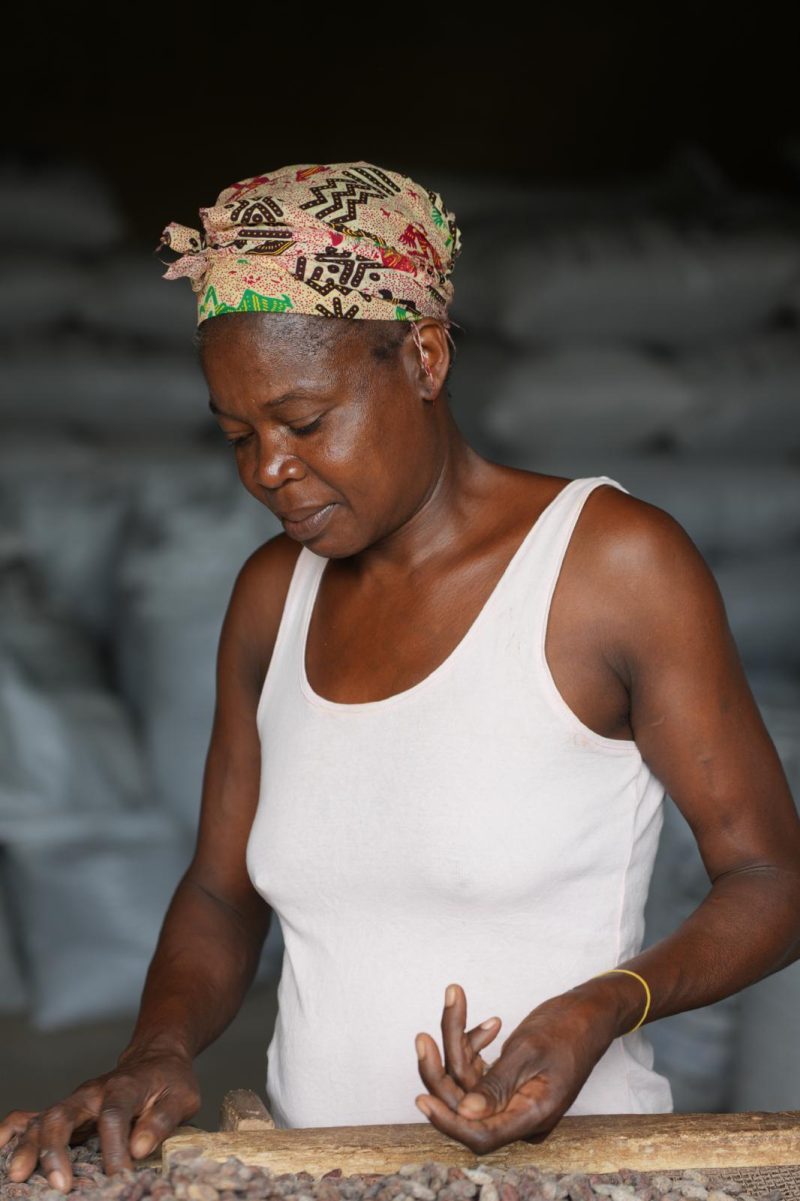
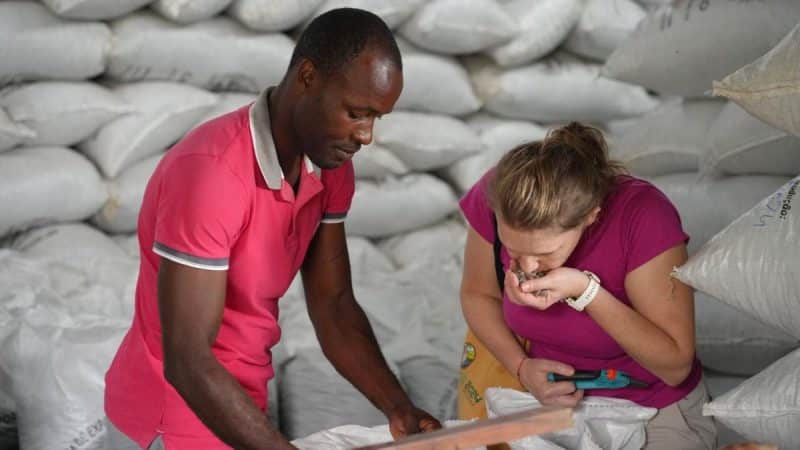
CECAQ-11’s CANTAGALO Organic cacao beans are already attracting the interest of skilled chocolatiers, with the cooperative’s dedication on the legendary Chocolate Island evident in every bean.
CECAQ-11 – CANTAGALO ORGANIC
Flavour Profile: Expect a classic chocolate base with deep, rich notes and a subtle herbal character -a true reflection of São Tomé’s vibrant terroir.
Type: Regional cacao
Region: Cantagalo
Source: Cooperative CECAQ-11
Founded: in 2008 by 221 cacao producers grouped into 11 associations from the historic roça Água Izé,
Certification: Fair Trade & Organic certified
Fermentation: Centrally, 5-7 days in wooden boxes
Drying: natural drying on covered African beds
EUDR ready !
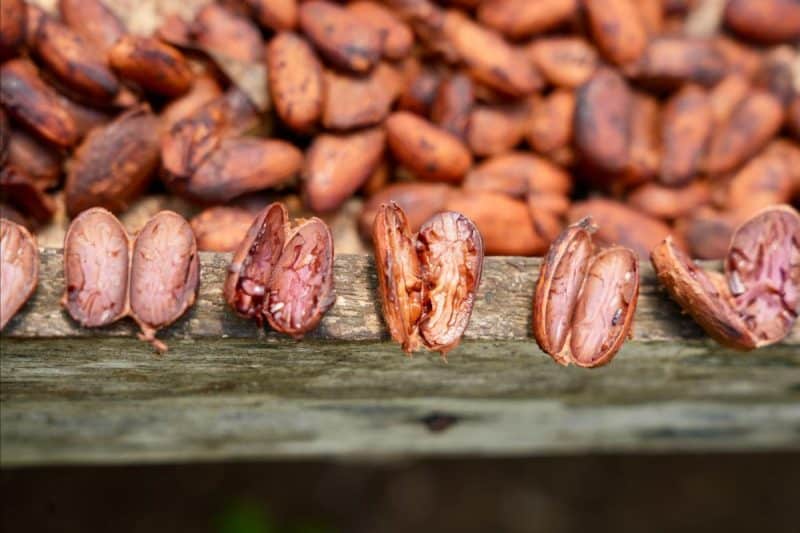
MLM
PRIVATE INITIATIVE WITH A HEART
Cacao has been partnering with MLM for the past two years, collaborating closely to elevate quality and refine post-harvest protocols.
Maxence -the driving force behind MLM, represents the new wave of São Tomé cacao. With strong personal ties to the island and a bold vision for its future, he revitalised a post-harvest center in Santa Amaro that has been in operation for over 100 years. Maxence modernised the facilities, upgraded drying beds, and assembled a dedicated team focused on quality and operations.

Joaquim, a cacao veteran with over 40 years of experience in cacao collection, is Maxence’s right hand and is strongly connected with the local communities.
Throughout our training sessions in Summer 2024 and our field visit in December 2024, we worked intensively together to further elevate the quality. This year, Clément joined the team to oversee post-harvest operations and ensure the smooth running of the centre. As a result, the samples arriving in Belgium continue to improve, with each shipment showing marked progress in quality. Full traceability and EUDR compliance are firmly in place, ensuring transparency at every step.
MLM collaborates with a network of 200 dedicated local smallholder farmers –ensuring that their hard work results in beans perfectly suited for fine chocolate makers. Beyond quality, these farmers benefit from social security, assistance in formalising land titles, and support to enhance their farming practices.
The first container from the current small harvest season is already on its way, expected to arrive at the end of May in Belgium. The sample is showing great promise: small beans with a lively, fruit-forward profile that brings out notes of raspberry, sour cherry, and a pleasant acidity on the finish.
We are incredibly proud of our collaboration with MLM and look forward to what lies ahead!
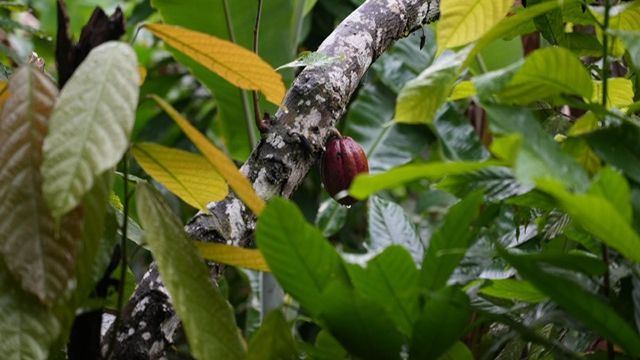
Flavour Profile: Bold, intense chocolate base with notes of dried prunes and a herbal hint
Type: Regional cacao
Region: Mé-Zóchi & Lobata
Founded: 2023 by Maxence
Certification: Not certified, but organic (by nature)
Fermentation & Drying: 6 days in horizontal wooden boxes
Drying: Sun-dried on covered wooden beds
EUDR ready !
Flavour Profile: Round and creamy cacao with a pleasant fresh hint of red fruits, cooked prunes, dried raisins, and an addictive cookie finish.
Type: Regional cacao
Region: Mé-Zóchi & Lobata
Founded: 2023 by Maxence
Certification: Not certified, but organic (by nature)
Fermentation & Drying: 7 days in horizontal wooden boxes
Drying: Sun-dried on covered wooden beds
EUDR ready !
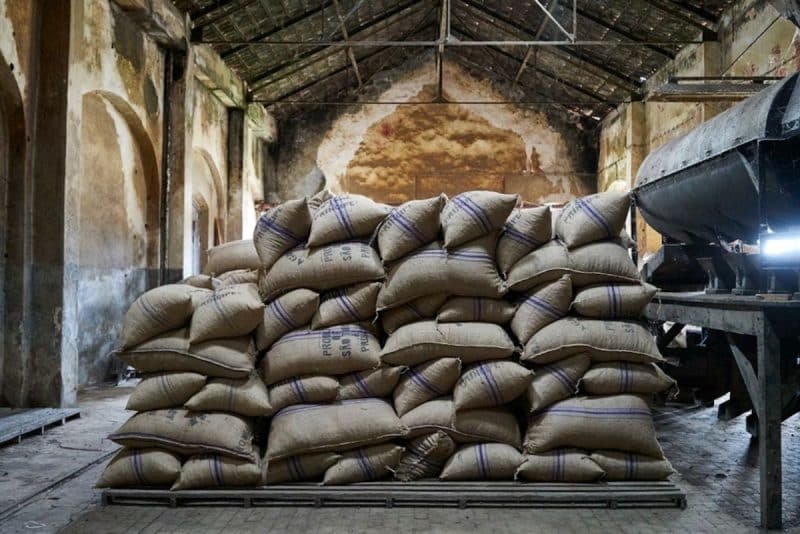
NOTES, KUDO’S, CREDITS & INSPO
*The roça (pronounced raw-sa) was the cornerstone of cacao and coffee production in São Tomé and Príncipe during the plantation era. These large agricultural estates were designed as self-sufficient settlements, with a central plaza that served as the hub of daily activity -used for roll calls, public gatherings, and most notably, for drying cacao beans in the sun. Surrounding the plaza were administrative buildings, processing facilities, workshops, storage units, and housing. The cacao production process was well-organised: harvested pods were taken to fermentation houses, where beans underwent several days of controlled fermentation to develop flavor. They were then dried -either directly on the plaza or on elevated racks, and stored in warehouses before export. Some roças even had narrow-gauge rail lines and carts to move beans from fields to processing areas and coastal ports more efficiently.
Laborers lived in communal housing known as senzalas, while plantation managers resided in the patrão, often a prominent Mediterranean-style residence. Many roças also included schools, chapels, and hospitals, which reflected their scale and autonomy. Daily work was organised and divided by task: men typically harvested cacao pods, while women often handled post-harvest activities like bean extraction, fermentation, and drying. By the early 1900s, roças covered more than 70,000 hectares across the islands and played a central role in making São Tomé and Príncipe one of the world’s leading cacao exporters. Though many of these structures are now in disrepair or repurposed, they remain important markers of the islands’ agricultural heritage.
** crioulo: person of African ancestry
***CECAQ-11 – Coopérative d’Exportation de Cacao Conventionnel de Qualité
SILVA CACAO – Brazil, the country of Carnival and Cacao
SILVA CACAO – Brazilian Cacao History
CECAQ-11 – CANTAGALO ORGANIC
MLM – MATÔ MUÍO
MLM – MATÔ SONHÔTO
